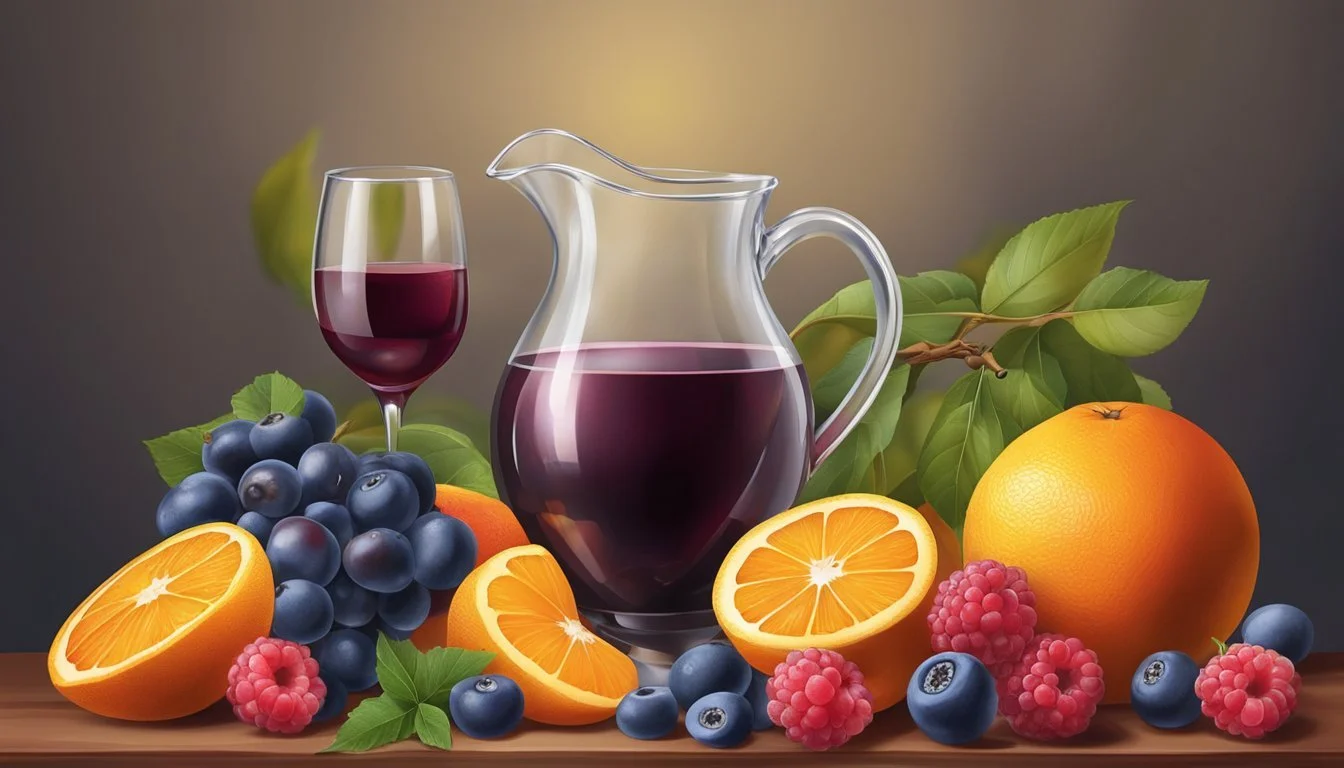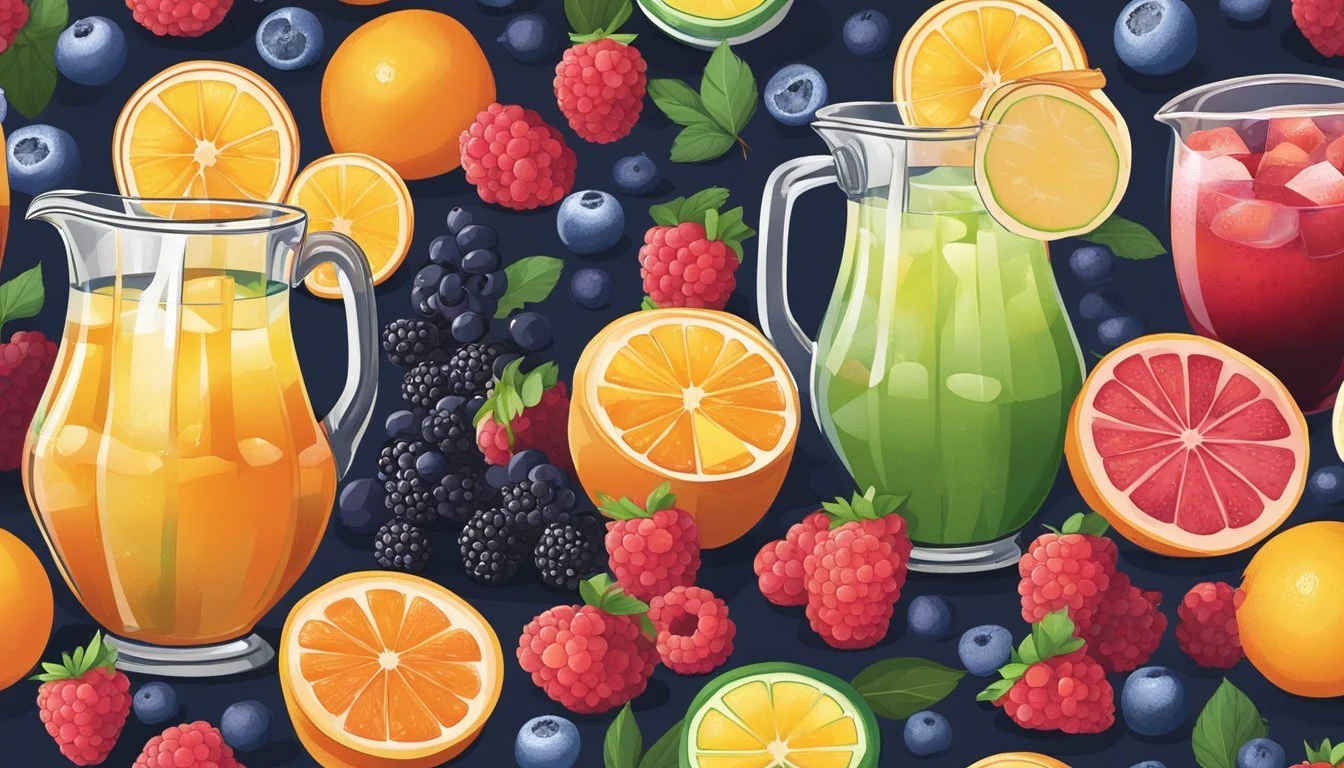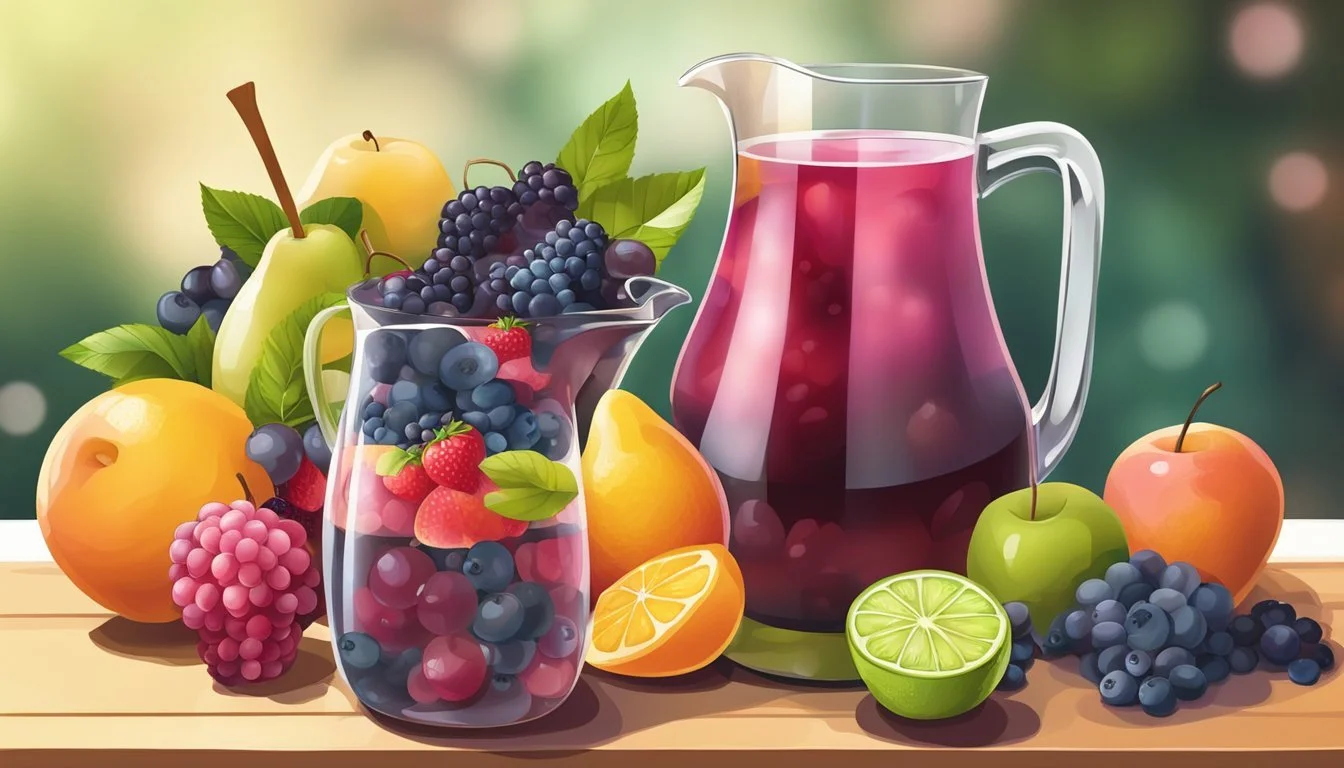Fresh vs. Frozen Fruit: Crafting the Ultimate Sangria Experience
Sangria, the beloved Spanish cocktail, offers a refreshing blend of wine and fruit perfect for summer gatherings. This versatile drink allows for creativity in fruit selection, with both fresh and frozen options available. Using frozen fruit in sangria not only chills the drink but also intensifies the flavors as it thaws.
The choice between fresh and frozen fruit depends on personal preference and convenience. Fresh fruit provides vibrant colors and crisp textures, while frozen fruit offers practicality and consistency. Some fruits, like raspberries and blood oranges, work particularly well in sangria, adding bursts of flavor and appealing hues to the drink.
Experimenting with different fruit combinations can lead to unique and delicious sangria variations. Whether opting for fresh or frozen, the key lies in selecting fruits that complement the wine and enhance the overall taste profile. This flexibility makes sangria an ideal cocktail for parties, allowing hosts to cater to various tastes and preferences.
Choosing the Right Wine
The foundation of any great sangria lies in selecting an appropriate wine. The choice impacts the overall flavor profile and complements the fruits and other ingredients.
Red Wine Selection
Opt for medium-bodied Spanish red wines like Rioja or Tempranillo for traditional sangria. These varieties offer balanced tannins and fruit-forward flavors that pair well with citrus and berries. Pinot Noir can be an excellent alternative, providing a lighter touch with bright acidity. For a bolder sangria, consider Cabernet Sauvignon or Merlot.
Avoid expensive wines, as the fruit and other additions will mask subtle flavors. Look for bottles in the $10-15 range for the best value. Young wines work better than aged ones, as their fresh fruit characteristics shine through in the final drink.
White Wine Alternatives
White sangria offers a refreshing twist on the classic recipe. Crisp, unoaked whites like Sauvignon Blanc or Albariño are ideal choices. These wines bring zesty citrus notes and enough acidity to balance the sweetness of added fruits.
Avoid heavily oaked Chardonnays, as they can clash with the fruity elements. Instead, try a Spanish Verdejo or a light Italian Pinot Grigio. These wines provide a neutral base that allows the fruit flavors to take center stage.
For a unique touch, experiment with slightly effervescent wines like Vinho Verde. The subtle bubbles add a lively texture to the sangria.
Rosé and Variations
Rosé wines offer a delightful middle ground between red and white sangrias. Choose dry rosés from Provence or Spanish Garnacha-based versions for best results. These wines contribute subtle berry flavors and a beautiful pink hue to the drink.
For a sparkling variation, use Cava or Prosecco as the base. The bubbles add a festive touch and enhance the overall refreshment factor. When using sparkling wines, add them just before serving to preserve the effervescence.
Experiment with fruit-infused wines or even wine blends to create unique sangria flavors. Remember to taste-test your combinations before serving to ensure a balanced and delicious result.
Fresh vs Frozen Fruit
Choosing between fresh and frozen fruit for sangria impacts flavor, texture, and convenience. Both options have distinct advantages depending on the situation and desired outcome.
Benefits of Fresh Fruit
Fresh fruit adds vibrant flavors and crisp textures to sangria. Oranges, strawberries, and limes provide zesty notes and appealing visuals. Apples contribute crunch and absorb the wine's flavors.
Fresh fruit typically has higher vitamin C content than frozen alternatives. It also allows for creative garnishing and presentation. Sliced citrus fruits or whole berries can be artfully arranged in glasses.
Using fresh fruit gives control over ripeness and quality. This ensures optimal taste and texture in the final drink.
When to Choose Frozen Fruit
Frozen fruit offers convenience and year-round availability. It's pre-washed and pre-cut, saving preparation time. Frozen berries like raspberries and blueberries release their juices quickly, infusing sangria with rich color and flavor.
Frozen fruit acts as natural ice cubes, keeping sangria cold without diluting it. This is especially useful for outdoor events or hot summer days.
Nutritionally, frozen fruit is comparable to fresh. It's often picked at peak ripeness and flash-frozen, preserving vitamins and minerals.
Dealing with Seasonal Fruit
Seasonal availability affects fruit choices for sangria. Summer fruits like peaches and plums are ideal when fresh. In off-seasons, frozen alternatives maintain quality and flavor.
Mixing fresh seasonal fruits with frozen staples creates balance. This approach ensures variety while managing costs and availability.
Consider using frozen fruit for out-of-season favorites. Strawberries in winter or peaches in fall can still star in sangria when sourced from the freezer aisle.
Experimenting with less common frozen fruits like mango or pineapple adds unique twists to traditional sangria recipes.
Crafting the Perfect Sangria
Sangria's allure lies in its harmonious blend of wine, fruits, and spirits. The key to crafting an exceptional sangria lies in balancing flavors, achieving the right consistency, and selecting complementary ingredients.
Balancing Flavors
A well-crafted sangria harmonizes sweet, tart, and fruity notes. Start with a base wine - red wines like Grenache work well for traditional sangrias, while white wines offer a lighter alternative. Add fresh fruits such as oranges, lemons, and apples to infuse vibrant flavors. Berries and stone fruits contribute depth and complexity.
Citrus juices brighten the mix. Squeeze fresh orange juice directly into the pitcher for a zesty kick. Lemon juice can add a tart element, balancing sweetness.
Consider the wine's tannins when mixing red sangria. Softer tannins blend more smoothly with fruit flavors. For white sangria, choose crisp, fruity wines to complement added fruits.
Consistency and Texture
Sangria's texture can range from light and refreshing to rich and bold. For a classic sangria, use fresh fruits cut into small pieces. This allows flavors to meld while maintaining a fresh, juicy texture.
Frozen fruits offer convenience and act as natural ice cubes, keeping the drink cool without dilution. They work particularly well in frozen sangria recipes, creating a slushy consistency perfect for hot days.
To achieve a smoother texture, muddle softer fruits like berries before adding wine. This releases juices and creates a more integrated flavor profile.
Chill the sangria for at least 30 minutes before serving to allow flavors to meld. Longer refrigeration, up to 4 hours, enhances flavor fusion.
The Role of Sweeteners
Sweeteners balance acidity and enhance fruit flavors in sangria. Simple syrup is a versatile option, easily adjusting sweetness levels. To make it, dissolve equal parts sugar and water over heat, then cool before adding.
Natural alternatives like honey or maple syrup impart unique flavors. Honey adds floral notes, while maple syrup contributes a rich, caramel-like sweetness.
For a lighter touch, use fresh fruit juice as a natural sweetener. Apple or white grape juice complement both red and white sangrias without overpowering the wine.
Taste the sangria before adding sweeteners, as some wines and fruits may provide sufficient sweetness on their own.
Adding Spirits and Liqueurs
Spirits and liqueurs elevate sangria's complexity and boost its alcoholic content. Brandy is a classic addition, providing warmth and depth. For a lighter touch, white rum pairs well with fruit flavors, especially in white sangrias.
Liqueurs offer flavor and sweetness. Triple sec or Cointreau enhance citrus notes, while berry liqueurs complement fruit-forward sangrias. Add these in small amounts, tasting as you go to avoid overpowering the wine.
For a unique twist, try Campari in red sangria. Its bitterness contrasts nicely with sweet fruits and adds complexity to the flavor profile.
Macerate fruits in spirits for a few minutes before adding wine. This step intensifies fruit flavors and creates a more cohesive blend.
Sangria Presentation and Serving
The visual appeal and serving method of sangria can elevate the drinking experience. Proper glassware, creative garnishes, and thoughtful presentation techniques enhance the enjoyment of this fruity beverage.
Selecting the Right Glassware
Wine glasses or large tumblers work well for serving sangria. Their wide bowls allow the aromas to develop and provide space for ice and fruit. For a more casual vibe, mason jars or sturdy goblets are excellent choices. Clear glasses showcase the vibrant colors of the drink and floating fruit pieces.
Pitchers for mixing and serving should be glass or crystal to display the sangria's rich hues. Opt for pitchers with wide mouths to accommodate fruit and ice easily. Some hosts use drink dispensers for larger gatherings, enabling guests to serve themselves.
Garnishing Techniques
Garnishes add visual appeal and extra flavor to sangria. Slice citrus fruits thinly and float them on top of the drink. Skewer berries or melon balls on cocktail picks for an elegant touch. Fresh herbs like mint or basil can be added as aromatic garnishes.
Create fruit ice cubes by freezing small pieces of fruit in water. These not only keep the drink cool but also add a decorative element as they melt. For a professional look, rim glasses with colored sugar or salt that complements the sangria's flavors.
Serving Sangria at Events
Sangria is perfect for brunches, barbecues, and summer parties. Set up a sangria bar with different fruit options, allowing guests to customize their drinks. Provide ladles or long-handled spoons for easy serving.
Keep sangria chilled in ice buckets or coolers during outdoor events. For large gatherings, prepare batches in advance and refill serving pitchers as needed. Offer both red and white sangria varieties to cater to different preferences.
Consider creating sangria popsicles or slushies for a unique twist at summer parties. These frozen treats are refreshing and Instagram-worthy. Pair sangria with light appetizers or tapas to complement its fruity flavors and enhance the overall dining experience.
Creating Frozen Sangria Variations
Frozen sangria offers a refreshing twist on the classic cocktail. This chilled beverage combines wine, fruit, and ice for a cool summer treat.
Using a Blender for Frozen Sangria
A blender is essential for creating smooth frozen sangria. Add wine, frozen fruit, and ice to the blender. Pulse until the mixture reaches a slushy consistency. For extra flavor, include orange juice or lime juice.
Adjust the amount of ice to control thickness. More ice creates a thicker drink, while less results in a more liquid texture.
Blend in batches for larger quantities. This ensures even mixing and prevents overloading the blender.
Frozen Fruit Options
Frozen fruit adds flavor and helps create the icy texture. Strawberries, peaches, and mixed berries work well. These fruits complement the wine and add natural sweetness.
Use store-bought frozen fruit or freeze fresh fruit ahead of time. To freeze fruit, wash and cut it into small pieces. Spread on a baking sheet and freeze until solid.
Experiment with different fruit combinations. Try tropical mixes with pineapple and mango, or stick to classic sangria fruits like oranges and apples.
Frozen Sangria Slushie
For a slushie-like consistency, increase the ice-to-liquid ratio. Start with 2 cups of ice per 1 cup of liquid. Adjust as needed to reach the desired texture.
Add a splash of brandy or rum for an extra kick. This boosts flavor and helps prevent the mixture from freezing solid.
Serve immediately after blending for the best texture. If needed, store in the freezer and re-blend briefly before serving. Garnish with fresh fruit slices or mint leaves for an attractive presentation.
Pairing Sangria with Food
Sangria's fruity flavors complement a variety of dishes, making it a versatile drink for meals and gatherings. The right food pairings can enhance the sangria experience, creating a delightful combination of flavors.
Sangria and Tapas
Sangria pairs exceptionally well with traditional Spanish tapas. Small plates of olives, manchego cheese, and jamón serrano create a perfect balance with the wine's sweetness. Patatas bravas, crispy potatoes served with spicy tomato sauce, offer a delicious contrast to sangria's fruity notes.
Seafood tapas like gambas al ajillo (garlic shrimp) or calamares fritos (fried squid) complement the refreshing qualities of sangria. For vegetarian options, try pan con tomate (bread with tomato) or espinacas con garbanzos (spinach with chickpeas).
Empanadas, filled with meat or vegetables, provide a hearty option that pairs nicely with sangria's bold flavors. Croquetas, small fried rolls filled with béchamel and ham or cheese, offer a creamy texture that contrasts well with the drink.
Planning for a Summer Party
Sangria is an ideal beverage for summer gatherings. When planning a party, consider easy-to-eat foods that complement the drink. Fresh fruit platters with berries, peaches, and oranges echo sangria's fruity profile and provide a refreshing option for guests.
Grilled foods work well with sangria. Prepare skewers with marinated chicken, beef, or vegetables for a simple yet flavorful option. Seafood dishes like grilled shrimp or fish tacos pair excellently with white wine sangria variations.
Light salads with mixed greens, goat cheese, and nuts offer a refreshing contrast to sangria's sweetness. For dessert, serve fruit-based treats like berry tarts or peach cobbler to complement the drink's flavors.
Consider offering both red and white sangria variations to cater to different tastes. Provide non-alcoholic options like fruit-infused water or mocktails for guests who prefer not to drink alcohol.
Advanced Sangria Tips
Elevate your sangria game with regional variations and recipe refinements. These techniques will help you craft exceptional sangrias tailored to different tastes and occasions.
Exploring Regional Variations
Spanish sangria varies across regions, offering unique flavor profiles. In Barcelona, sangria often includes cava, a sparkling wine, for added effervescence. Catalan sangria incorporates local fruits like peaches and nectarines. Andalusian versions may feature sherry wine and citrus fruits.
Some regions add herbs like rosemary or mint for aromatic depth. Others incorporate spices such as cinnamon or star anise. Experimenting with these regional touches can create distinctive sangrias.
Basque Country sangria often includes txakoli, a local white wine, and sidra, an apple cider. This creates a lighter, more refreshing drink perfect for summer.
The Art of Perfecting the Recipe
Balancing flavors is key to an exceptional sangria. Start with a base wine that complements the chosen fruits. For red sangria, tempranillo or garnacha work well. White sangrias benefit from albariño or verdejo.
Macerate fruits in liquor before adding wine to intensify flavors. Brandy is traditional, but experimenting with other spirits can yield interesting results. Allow the mixture to chill for at least 2 hours, or ideally overnight, for optimal flavor infusion.
Garnishes elevate presentation and add final touches of flavor. Fresh mint leaves, citrus wheels, or edible flowers make attractive additions. For serving, use large wine glasses or traditional clay pitchers called "porrones" for an authentic Spanish touch.








